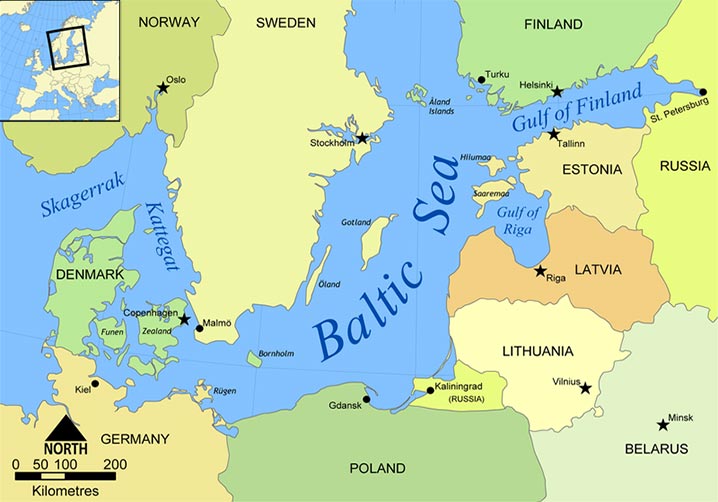Baltic Defense Cooperation Agreement: Official U.S. position

Official U.S. position on the newly signed Baltic Defense Cooperation Agreement:
· The United States signed Defense Cooperation Agreements (DCAs) with Latvia, Lithuania, and Estonia. These agreements establish the framework for enhanced partnership and defense and security cooperation between the United States and our NATO Allies.
· This new bilateral agreements will supplement existing agreements between the United States and its allies concluded bilaterally and through the NATO Alliance, further supporting our rotational military presence through the European Reassurance Initiative.
· As NATO Allies and global partners, the United States, Latvia, Lithuania, and Estonia remain unwavering in their commitment to mutual defense, including building national resilience in line with the pledge made by all Allies.
What exactly do the new agreements accomplish?
· The new DCAs replace previous Access Agreements the United States concluded with Estonia, Latvia, and Lithuania in 2015, which permitted U.S. forces to improve military facilities and areas for use in European Reassurance Initiative activities.
· The DCAs supplement the terms and conditions set forth in the NATO Status of Forces Agreement (SOFA) and are similar to supplemental agreements we have with many NATO Allies. Together with the NATO SOFA, they provide the necessary legal framework for U.S. forces operating in the Baltic states.
· The conclusion of these DCAs reaffirms our enduring commitment to robust bilateral defense relationships with each of these Allies, and underscores our broader commitment to the transatlantic alliance and collective security in Europe.
Besides rotational deployments, what has the United States done to bolster the security of the Baltic states?
In 2016, we launched the U.S.-Baltic Security Cooperation Dialogue in order to develop our range of security cooperation activities with our regional allies through defense trade, training exercises, and security assistance programs such as the European Reassurance Initiative, Foreign Military Financing, and International Military Education and Training.
Our defense trade and security assistance priorities focus on increasing capabilities for NATO interoperability and building national resilience and internal defense for traditional and non-traditional threats, such as cyber and hybrid warfare.
Latvia, Lithuania, and Estonia each received more than $30 million worth of equipment through 2015 European Reassurance Initiative funds. The United States also provided each country with more than $6 million in Foreign Military Financing in 2015 and $9 million in 2016, demonstrating a heightened awareness to the threats faced by our Baltic allies.
Latvia, Lithuania, and Estonia each receives about $1.2 million annually in International Military Education and Training assistance to support professional military education for mid-level and senior military officers.
U.S. forces cooperate with our Baltic allies in a variety of training events, including exercises led by NATO. The longstanding U.S.-led BALTOPS and SABER STRIKE series are considered flagship exercises in the region and are performed on an annual basis.
For more than 20 years, Latvia, Lithuania, and Estonia have collaborated with the Maryland, Michigan, and Pennsylvania National Guard units through the State Partnership Program, which brings together military personnel for training, education, and related activities.
Background on Enhanced Forward Presence (eFP)
At the Warsaw Summit, allied leaders agreed to improve collective defense by enhancing NATO’s forward presence on the eastern flank through the deployment of one rotational battalion each in Estonia, Latvia, Lithuania, and Poland, as well as developing a tailored forward presence in Romania and Bulgaria.
The United States, United Kingdom, Germany, and Canada each agreed to lead one multinational NATO battle group deployed on a persistent rotational basis to Poland, Estonia, Lithuania, and Latvia, respectively.
We are grateful to our Allies working together to ensure Europe’s security.
All eFP troops will be deployed on a rotational basis.
These deployments are clearly defensive, and fully consistent with the NATO-Russia Founding Act. In contrast, Russia has not exercised similar restraint. Its actions against Ukraine have violated both international law and the commitments Russia has made.
Why are the U.S. forces currently stationed in the Baltics being withdrawn?
We are committed to a robust, rotational NATO presence in all three Baltic nations.
The United States will maintain company-level presence in the Baltics until the arrival of Allied eFP battle groups. With the arrival of Allied eFP battle groups, the U.S. presence in the Baltics will transition to a more flexible exercise-driven approach.
The United States will continue to maintain an extremely robust calendar of training, exercises, and partnership events in the Baltic States, on top of NATO’s eFP commitment.
Why does NATO continue to pursue rotational deployments in the Baltics and Poland? Wouldn’t a permanent presence be more effective?
To respond to twenty-first century security challenges – including cyber, hybrid, and unconventional threats – we need NATO forces to be fast, mobile, able to surge quickly, and not tied to one place. This is why we are enhancing our military presence in NATO’s east with rotational deployments in the air, on land, and at sea.
Don’t these DCAs validate Russia’s assertion that the United States and NATO are acting provocatively?
No. NATO is a defensive alliance, and neither NATO nor the United States seek conflict with Russia.
The United States has similar supplemental agreements with many NATO Allies to provide a baseline legal framework for the conduct of mutually agreed activities in the North Atlantic Treaty region.

